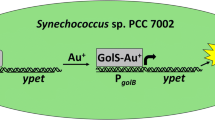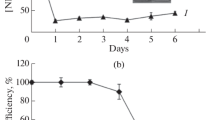Abstract
Acidithiobacillus spp. are the most active bacteria in bioleaching and bioremediation, because of their remarkable extreme environmental adaptabilities and unique metabolic characteristics. The researches on regulatory mechanisms of energy metabolism and stress resistance are critical for the understanding and application of Acidithiobacillus spp. However, the lack of an ideal reporter gene has become an obstacle for studying genes expression and regulatory mechanism in these chemoautotrophic bacteria. In this study, we reported the firefly luciferase as a reporter gene for Acidithiobacillus caldus (A. caldus) and created a firefly luciferase (Luc) reporter system. The Luc system was applied for the quantitative analysis of the transcription strength of the promoters of tetH gene and the feoA gene in A. caldus. Moreover, the regulating effect of ferric uptake regulator (Fur) on the feoP gene in A. caldus was determined using the Luc system. The Luc reporter system is not only used in the study of regulatory mechanism of A. caldus, but also applied in the researches of other Acidithiobacillus species. Therefore, this study provides a new useful tool for the studies on the molecular biological mechanism and synthetic biological modification of these chemoautotrophic bacteria, which would promote the industrial application of Acidithiobacillus spp.




Similar content being viewed by others
References
Chen LX, Huang LN, Mendez-Garcia C, Kuang JL, Hua ZS, Liu J, Shu WS (2016) Microbial communities, processes and functions in acid mine drainage ecosystems. Curr Opin Biotechnol 38:150–158. https://doi.org/10.1016/j.copbio.2016.01.013
Arce-Rodríguez A, Puente-Sánchez F, Avendaño R, Martínez-Cruz M, de Moor JM, Pieper DH, Chavarría M (2019) Thermoplasmatales and sulfur-oxidizing bacteria dominate the microbial community at the surface water of a CO2-rich hydrothermal spring located in Tenorio Volcano National Park. Costa Rica Extrem 23(2):177–187. https://doi.org/10.1007/s00792-018-01072-6
Wang R, Lin JQ, Liu XM, Pang X, Zhang CJ, Yang CL, Gao XY, Lin CM, Li YQ, Li Y, Lin JQ, Chen LX (2018) Sulfur oxidation in the acidophilic autotrophic Acidithiobacillus spp. Front Microbiol 9:3290. https://doi.org/10.3389/fmicb.2018.03290
Nancharaiah YV, Mohan SV, Lens PNL (2016) Biological and bioelectrochemical recovery of critical and scarce metals. Trends Biotechnol 34(2):137–155. https://doi.org/10.1016/j.tibtech.2015.11.003
Hedrich S, Johnson DB (2014) Remediation and selective recovery of metals from acidic mine waters using novel modular bioreactors. Environ Sci Technol 48(20):12206–12212. https://doi.org/10.1021/es5030367
Işıldar A, van de Vossenberg J, Rene ER, van Hullebusch ED, Lens PNL (2016) Two-step bioleaching of copper and gold from discarded printed circuit boards (PCB). Waste Manag 57:149–157. https://doi.org/10.1016/j.wasman.2015.11.033
Zhang MJ, Jiang CY, You XY, Liu SJ (2014) Construction and application of an expression vector from the new plasmid pLAtc1 of Acidithiobacillus caldus. Appl Microbiol Biotechnol 98(9):4083–4094. https://doi.org/10.1007/s00253-014-5507-z
Fang Y, Zhu C, Chen X, Wang Y, Xu M, Sun G, Guo J, Yoo J, Tie C, Jiang X, Li X (2018) Copy number of ArsR reporter plasmid determines its arsenite response and metal specificity. Appl Microbiol Biotechnol 102(13):5753–5761. https://doi.org/10.1007/s00253-018-9042-1
Wang H, Fang L, Wen Q, Lin J, Liu X (2017) Application of beta-glucuronidase (GusA) as an effective reporter for extremely acidophilic Acidithiobacillus ferrooxidans. Appl Microbiol Biotechnol 101(8):3283–3294. https://doi.org/10.1007/s00253-017-8116-9
Chen S, Bleam WF, Hickey WJ (2009) Simultaneous analysis of bacterioferritin gene expression and intracellular iron status in Pseudomonas putida KT2440 by using a rapid dual luciferase reporter assay. Appl Environ Microbiol 75(3):866–868. https://doi.org/10.1128/AEM.01823-08
Yang CL, Chen XK, Wang R, Lin JQ, Liu XM, Pang X, Zhang CJ, Lin JQ, Chen LX (2019) Essential role of sigma factor RpoF in flagellar biosynthesis and flagella-mediated motility of Acidithiobacillus caldus. Front Microbiol 10:1130. https://doi.org/10.3389/fmicb.2019.01130
Chen X-k, Li X-y, Ha Y-f, Lin J-q, Liu X-m, Pang X, Lin J-q, Chen L-x (2020) Ferric uptake regulator provides a new strategy for acidophile adaptation to acidic ecosystems. Appl Environ Microbiol 86(11):e00268–e1220. https://doi.org/10.1128/AEM.00268-20
Wang ZB, Li YQ, Lin JQ, Pang X, Liu XM, Liu BQ, Wang R, Zhang CJ, Wu Y, Lin JQ, Chen LX (2016) The two-component system RsrS-RsrR regulates the tetrathionate intermediate pathway for thiosulfate oxidation in Acidithiobacillus caldus. Front Microbiol 7:1755. https://doi.org/10.3389/fmicb.2016.01755
Wang R, Lin C, Lin J, Pang X, Liu X, Zhang C, Lin J, Chen L (2017) Construction of novel pJRD215-derived plasmids using chloramphenicol acetyltransferase (cat) gene as a selection marker for Acidithiobacillus caldus. PLoS ONE 12(8):e0183307. https://doi.org/10.1371/journal.pone.0183307
van Zyl LJ, van Munster JM, Rawlings DE (2008) Construction of arsB and tetH mutants of the sulfur-oxidizing bacterium Acidithiobacillus caldus by marker exchange. Appl Environ Microbiol 74(18):5686–5694. https://doi.org/10.1128/AEM.01235-08
Osorio H, Martinez V, Nieto PA, Holmes DS, Quatrini R (2008) Microbial iron management mechanisms in extremely acidic environments: comparative genomics evidence for diversity and versatility. BMC Microbiol 8:203. https://doi.org/10.1186/1471-2180-8-203
Quatrini R, Lefimil C, Veloso FA, Pedroso I, Holmes DS, Jedlicki E (2007) Bioinformatic prediction and experimental verification of Fur-regulated genes in the extreme acidophile Acidithiobacillus ferrooxidans. Nucleic Acids Res 35(7):2153–2166. https://doi.org/10.1093/nar/gkm068
Kusano T, Sugawara K, Inoue C, Takeshima T, Numata M, Shiratori T (1992) Electrotransformation of Thiobacillus ferrooxidans with plasmids containing a mer determinant. J Bacteriol 174(20):6617. https://doi.org/10.1128/jb.174.20.6617-6623.1992
Chen L, Lin J, Li B, Lin J, Liu X (2010) Method development for electrotransformation of Acidithiobacillus caldus. J Microbiol Biotechnol 20(1):39–44. https://doi.org/10.4014/jmb.0905.05023
Peng JB, Yan WM, Bao XZ (1994) Plasmid and transposon transfer to Thiobacillus ferrooxidans. J Bacteriol 176(10):2892–2897. https://doi.org/10.1128/jb.176.10.2892-2897.1994
Nunez H, Covarrubias PC, Moya-Beltran A, Issotta F, Atavales J, Acuna LG, Johnson DB, Quatrini R (2016) Detection, identification and typing of Acidithiobacillus species and strains: a review. Res Microbiol 167(7):555–567. https://doi.org/10.1016/j.resmic.2016.05.006
Nguyen M-P, Yoon J-M, Cho M-H, Lee S-W (2015) Prokaryotic 2-component systems and the OmpR/PhoB superfamily. Can J Microbiol 61(11):799–810. https://doi.org/10.1139/cjm-2015-0345
Procaccini A, Lunt B, Szurmant H, Hwa T, Weigt M (2011) Dissecting the specificity of protein-protein interaction in bacterial two-component signaling: orphans and crosstalks. PLoS ONE 6(5):e19729. https://doi.org/10.1371/journal.pone.0019729
Howell A, Dubrac S, Andersen KK, Noone D, Fert J, Msadek T, Devine K (2003) Genes controlled by the essential YycG/YycF two-component system of Bacillus subtilis revealed through a novel hybrid regulator approach. Mol Microbiol 49(6):1639–1655. https://doi.org/10.1046/j.1365-2958.2003.03661.x
Dorsaz S, Coste AT, Sanglard D (2017) Red-shifted firefly luciferase optimized for Candida albicans in vivo bioluminescence imaging. Front Microbiol 8:1478. https://doi.org/10.3389/fmicb.2017.01478
Zhang X, Liu X, Li L, Wei G, Zhang D, Liang Y, Miao B (2019) Phylogeny, divergent evolution, and speciation of sulfur-oxidizing Acidithiobacillus populations. BMC Genomics 20(1):438. https://doi.org/10.1186/s12864-019-5827-6
Acknowledgements
This work was supported by grants from the National Natural Science Foundation of China (31570036, 31872621, 31570041.), the Project of Taishan Industry Leading Talent in Shandong province (LJNY201603), the State Key Laboratory of Microbial Technology Foundation (M2017-01), People’s Republic of China. We are grateful to Pro. Jun Fu from Shandong University for providing the plasmid pBR322-Luc containing firefly luciferase gene. We thank the supports from Core Facilities Sharing Platform for Life and Environment Sciences of Shandong University, including Rui Wang for luciferase activity detection, Cheng-jia Zhang and Nan-nan Dong for providing bacteriological incubator.
Author information
Authors and Affiliations
Contributions
XC contributes to the performance of experiments, the analysis of the data, the writing and visualization of the manuscript. XL and YG contribute to methods investigation and data validation. JL, XL and XP provide foundings and suggestions for this manuscript. JL and LC contribute to the design of experiment, the organization and modification of the manuscript.
Corresponding authors
Ethics declarations
Conflict of interest
All authors declare that they have no conflict of interest to declare.
Additional information
Publisher's Note
Springer Nature remains neutral with regard to jurisdictional claims in published maps and institutional affiliations.
Rights and permissions
About this article
Cite this article
Chen, X., Liu, X., Gao, Y. et al. Application of Firefly Luciferase (Luc) as a Reporter Gene for the Chemoautotrophic and Acidophilic Acidithiobacillus spp.. Curr Microbiol 77, 3724–3730 (2020). https://doi.org/10.1007/s00284-020-02195-w
Received:
Accepted:
Published:
Issue Date:
DOI: https://doi.org/10.1007/s00284-020-02195-w




